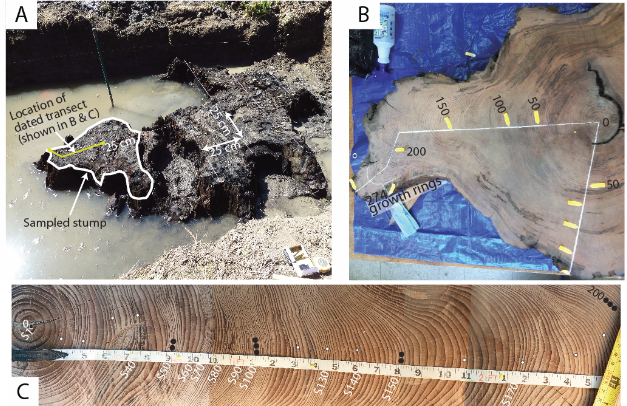Refining the View of the Past
Carbon is a shapeshifter. Its allotropes range from the hard diamond, to slippery graphite, to the electricity-conducting nanotube. From an imaginative standpoint, one of carbon’s isotopes (carbon-14) also allows it to shapeshift into a window through which science can peer into the past. Carbon has 3 isotopes of which two are stable—carbon-12 and carbon-13. The isotope carbon-14 however, is unstable or radioactive which means it releases energy in a process called “radioactive decay.” This radioactive nature allows scientists from a number of disciplines to use carbon-14 in radiocarbon dating to understand the timing of ancient natural phenomena like changes in climate, forest fires, and earthquakes. Ashley Streig, a paleoseismologist, is one such scientist who works to understand the timing of past earthquakes in hopes of better predicting future ones.
Block of sediment collected from the trench. Note the redwood leaf at the crack, where lithology changes from sand to fine silt. Black dots are the detrital charcoal.
Figuring for inbuilt age can extend the window of possible earthquake occurrence by 100s of years. This is nothing when compared to geologic time, but problematic if geologists want to understand if a fault historically ruptured every 70 years or every 270 years.
When digging into a section of the San Andreas Fault, in California, Streig and her team happened upon tree stumps in the same layer that showed evidence of a past earthquake. These tree stumps gave the team a unique opportunity to calibrate the ages they had already figured by radiocarbon dating of charcoal. Because the disrupted layer contained both tree stumps and tree shavings, the researchers knew the trees were logged within a few years of the time the earthquake happened. This allowed the researchers to count tree rings (dendrochronology) to narrow the window of possible earthquake occurrence and to calibrate this new information with the organic samples they had measured through radiocarbon dating. Even with the possibility for error factored in, this new technique allowed paleoseismologists to pinpoint the earthquake’s occurrence within a 10-year window, whereas using only typical radiocarbon dating left them with an error margin of 130 years.
Ashley Streig
Dr Ashley Streig in a Paleoseismologic trench on the northern San Andreas Fault, California USA
Living things absorb carbon: plants from the atmosphere, herbivores from eating those plants, and carnivores from eating the animals that eat those plants. When living things die, their absorption of carbon stops and carbon-14 begins to decay. The predictable decay pattern of carbon-14 means researchers can measure the carbon-14 in preserved organic material to determine their age. When that organic matter is in a layer of material disrupted by an ancient earthquake, paleoseismologists can estimate the date of that earthquake.
Yet this dating method has its limitations. Often the preserved organic material is in the form of charcoal–the leftover remains of burned plant material. When scientists date charcoal, they cannot always be sure of the “inbuilt age” of the material: the difference between the age of the material as determined by radiocarbon dating and the time that material settled into the geologic layer that shows evidence of the earthquake.
These are the slabs of buried stumps. Traced rings around the tree stump, and sampled individual tree rings for C14 analysis. The goal was to collect radiocarbon samples of rings and do wiggle matching and find the age of the outer ring.
Check out more of Ashley’s work, or get in touch
https://www.pdx.edu/profile/ashley-streig
streig@pdx.edu
https://www.researchgate.net/profile/Ashley-Streig-2
Watch Ashley Streig explain her research and her work in our Carbon Flash video series here.
Related Resources
This series has been conceptualised in collaboration with Jay Barber, a 2023 Fullbright-Nehru Academic and Professional Excellence Teaching Scholar. She has authored all the Carbon Flash writing pieces, and facilitated all the complementing interviews for the Carbon Flash videos as well.





